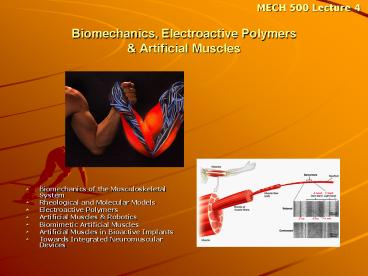Biomechanics, Electroactive Polymers
1 / 14
Title:
Biomechanics, Electroactive Polymers
Description:
Bionics refers to both (a) a biomimetic approach and (b) ... Force-velocity relationship arises only as a result of the contractile element. Limitations: ... –
Number of Views:204
Avg rating:3.0/5.0
Title: Biomechanics, Electroactive Polymers
1
Biomechanics, Electroactive Polymers
Artificial Muscles
MECH 500 Lecture 4
- Biomechanics of the Musculoskeletal System
- Rheological and Molecular Models
- Electroactive Polymers
- Artificial Muscles Robotics
- Biomimetic Artificial Muscles
- Artificial Muscles in Bioactive Implants
- Towards Integrated Neuromuscular Devices
2
Recap The story so far .
- Bionic Implants is a vast, multidisciplinary
effort involving biology, chemistry, mechanics
and electrophysiology - Bionics refers to both (a) a biomimetic approach
and (b) devices that interface bidirectionally
with the human body - Bionic Implants are based on biomimetic
multifunctional materials - Functional Tissue Engineering refers to the
re-engineering of living tissues using synthetic
scaffolds. - So far, we have used passive organs as examples
Bone, cartilage, ligaments .. - Now What about implants that move?
3
Biomechanics
- Study of locomotion and motility in living
systems using classical mechanical models and
paradigms - Critical to understanding the skeletal system,
fluid flow and movement in the human body, the
animal and plant world - Models derives are crucial to designing bionic
implants
4
Muscles
- At the nexus of chemistry, biology, mechanics and
electricity and thermodynamics
5
Muscle Bio-chemo-electro-mechanical system!
- Hierarchical Structure
- More than jsut a motor
- Responsible for motility throughout the human
body - Muscles are of three kinds
6
Types of Muscles in Humans
Cardiac Muscle
Skeletal Muscle
Smooth Muscle
7
Muscle More than a Motor!
- Motors Generate Force
- Brakes They absorb energy and damp vibrations
- Springs Store and Release Energy
- StrutsResists longitudanal compression
How Animals Move An Integrative View, Michael H.
Dickinson, VOL 288 7 APRIL 2000
8
Hills Model
- Seminal Work published in 1938
- Black Box model
- Force-velocity relationship arises only as a
result of the contractile element - Limitations
- Does not predict force enhancement/depression
- Does not account for non-linearities in the
muscle
Hills Equation (P a)(Vb) c
9
Huxleys Model Sliding Filament Theory
- Muscle Contraction activated by calcium Ions
- Force produced through overlap of actin and
myosin filaments
10
Co-operativity All or nothing
- Threshold calcium Ion concentration for
activation - Individual sarcomeres follow the all or
nothing rule - Why is this architecture favourable?
Hills equation Force Forcemax . Ca2N/
Ca50N Ca2N
11
Closed-Loop Control Feedback in Muscles
12
MUSCLES REMEMBER!
- Muscles are heirarchical structures
- Muscle fibers contract in an ALL or NOTHING
FASHION Critical Phenomenon - Individual Fibers are recruited DISCRETELY and
SEQUENTIALLY - Relaxation is coupled to contraction
- Force is transmitted to joints through TENDONS.
Why? - Closed-Loop Control
13
Artificial Muscle The Grand Challenge
- Challenge issued in 1999 by JPL, NASA
- Robot beaten by teenage girl in 2005
14
Artificial Muscles in Medicine Why are they
important?
- Assist weak muscles
- Drug Delivery
- Valves
- Pumps
- Bioactive Implants
- BIOMIMETIC (BIONIC) SOLUTION!






























